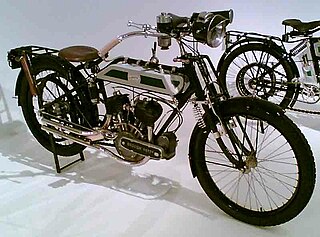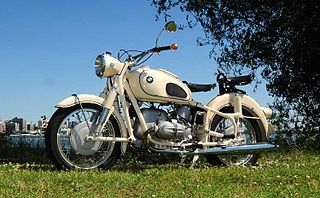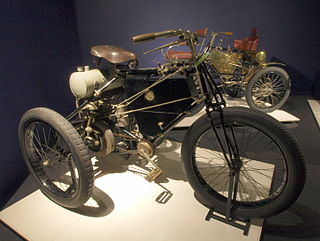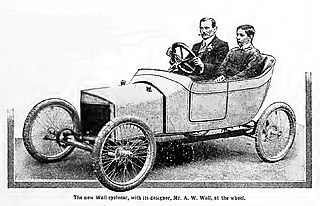
A flat-twin engine is a two-cylinder internal combustion engine with the cylinders on opposite sides of the crankshaft. The most common type of flat-twin engine is the boxer-twin engine, where both cylinders move inwards and outwards at the same time.

Velocette is a line of motorcycles made by Veloce Ltd, in Hall Green, Birmingham, England. One of several motorcycle manufacturers in Birmingham, Velocette was a small, family-owned firm, selling almost as many hand-built motorcycles during its lifetime, as the mass-produced machines of the giant BSA and Norton concerns. Renowned for the quality of its products, the company was "always in the picture" in international motorcycle racing, from the mid-1920s through the 1950s, culminating in two World Championship titles and its legendary and still-unbeaten 24 hours at over 100 mph (161 km/h) record. Veloce, while small, was a great technical innovator and many of its patented designs are commonplace on motorcycles today, including the positive-stop foot shift and swinging arm rear suspension with hydraulic dampers. The business suffered a gradual commercial decline during the late 1960s, eventually closing in February 1971.
Coventry Victor was a British motorcycle and car manufacturer. Originally Morton & Weaver, a proprietary engine manufacturer in Hillfields, Coventry, founded in 1904, the company changed its name to Coventry Victor Motors in 1911. The company closed in 1971.
The Scott Motorcycle Company was owned by Scott Motors (Saltaire) Limited, Shipley, West Yorkshire, England and was a well-known producer of motorcycles and light engines for industry. Founded by Alfred Angas Scott in 1908 as the Scott Engineering Company in Bradford, Yorkshire, Scott motorcycles were produced until 1978.

Brough Motorcycles were made by William E. Brough in Nottingham, England, from 1902 to 1926, after some earlier experimentation with motorised tricycles. The Brough Superior company was a separate company created by his son, George Brough.

Phelon & Moore manufactured motorcycles in Cleckheaton, Yorkshire, England from 1904 to 1967 particularly those under the Panther marque. They became identified with one particular design of motorcycle which had a large sloping 40-degree single-cylinder engine as a stressed member of the frame. This design spanned the entire history of the company, starting with a 500 cc model and ending with a 645 cc model.

Matchless is one of the oldest marques of British motorcycles, manufactured in Plumstead, London, between 1899 and 1966. A wide range of models were produced under the Matchless name, ranging from small two-strokes to 750 cc four-stroke twins. Matchless had a long history of racing success; a Matchless ridden by Charlie Collier won the first single-cylinder race in the first Isle of Man TT in 1907.

A motorcycle engine is an engine that powers a motorcycle. Motorcycle engines are typically two-stroke or four-stroke internal combustion engines, but other engine types, such as Wankels and electric motors, have been used.

The New Hudson Cycle Co. was originally started in 1890 by George Patterson, and manufactured 'safety' bicycles in Birmingham. In 1903 they produced their first motorcycle, but times became tough for Patterson after one of his sons died in WW1 and the other lost a leg. The family sold the factory to HJ Bructon after WW1, and in 1920 the company was reformed as New Hudson Ltd.

Douglas was a British motorcycle manufacturer from 1907–1957 based in Kingswood, Bristol, owned by the Douglas family, and especially known for its horizontally opposed twin cylinder engined bikes and as manufacturers of speedway machines. The company also built a range of cars between 1913 and 1922.

The R60 and R60/2 are 600 cc boxer-twin that were manufactured from 1956 to 1969 in Munich, Germany, by BMW.

The R69S, R69US, and R69 are motorcycles, fitted with 594 cc boxer twin engines, that were manufactured by BMW in Munich, Germany.
Rex, Rex Motorcycles, Rex-Acme, was a car and motorcycle company which began in Birmingham, England in 1900. Rex soon merged with a Coventry maker of bicycles and cars named Allard and then later in 1922 the company merged with Coventry's 'Acme' motorcycle company forming 'Rex Acme'. The company existed until 1933, and, in its heyday, was considered one of the greatest names in the British motorcycle industry.

ABC motorcycles was a British motorcycle manufacturer established in 1914 by Ronald Charteris in London. Several British motorcycle firms started up with the name "ABC", including Sopwith. The All British Engine Company Ltd. of London was founded in 1912 and later changed to ABC Motors Ltd. With chief engineer Granville Bradshaw, Charteris built a range of engines throughout the First World War. From 1913 ABC produced motorcycle engines.
The Advance Motor Manufacturing Company was a British motorcycle and engine manufacturer established in 1905. As well as supplying aircraft engines to the pioneering monoplane developers, Advance engines were also used by Captain Robert Scott to power Antarctic snow sleds. After the end of the Second World War the company was sold to Sheepbridge Engineering and became a motor supplies organisation.

Quadrant was one of the earliest British motorcycle manufacturers, established in Birmingham in 1901. Famous for their big singles, Quadrant pioneered many innovations that proved important for motorcycle development but struggled after the First World War and the company was wound up in 1928.

The De Dion-Bouton tricycle was the most successful motor vehicle in Europe from 1897 until 1901. With about 15,000 copies sold, the de-Dion-Bouton motor tricycle scored the first breakthrough for the distribution of motor vehicles. In particular the fast-running de Dion-Bouton engine set new standards for vehicular motors, and is regarded as the precursor of all motorcycle engines.

Hazlewoods Limited of Coventry were manufacturers of bicycles from 1895, and motorcycles from 1911 until closure c. 1923. They were typical many British companies who proceeded from bicycle manufacture to motorised bicycles, a change made possible by engine and geared hub suppliers.
F. E. Baker Ltd was a British motorcycle engine and cyclecar engine manufacturer based in the Precision Works, Moorsom Street, Birmingham, England. Founded in 1906 by Frank Edward Baker, the company produced motorcycle engines under the Precision trademark until 1919. Precision engines were used by a wide range of motorcycle manufacturers in the United Kingdom and in other parts of the Commonwealth and were also used in cyclecars. Many manufacturers used the 'Precision' trademark as part of their model names, and in 1912 there was a 'Precision' motorcycle sold in Australia, but it is unclear if this was manufactured by F.E. Baker or just permitted use of the trademark by a motorcycle manufacturer.

Arthur William Wall (c1874-1943) was an engineer in the field of motorised transport in England in the early 20th century. He is best known for his creation of the self-powered wheel, the Wall Autowheel, which could be used to power a bicycle, but he was also the man behind Roc motorcycles and a tricar and 4-wheel cyclecar. His main company was A.W. Wall Ltd, but he created several other companies to compartmentalise his different activities, such as the Roc Gear Co, who supplied epicyclic gears to a significant number of manufacturers before WW1.


















